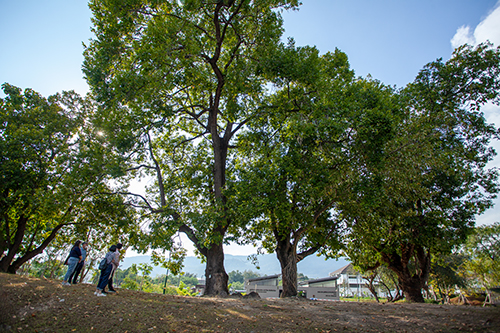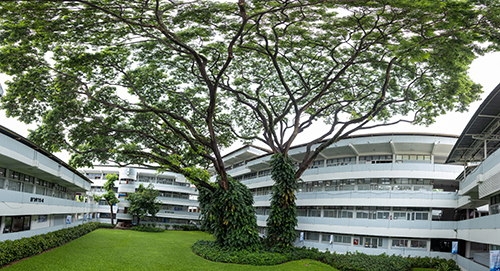Chiang Mai University’s campus is without a shadow of a doubt, one of the most spectacular in Thailand. The university’s main campus sits on a vast piece of land at the foothills of the Doi Suthep-Pui mountains, and is filled with trees, large and small, as the university seamlessly merges into the forests of the national park.
There are tens of thousands of trees on the grounds of Chiang Mai University – trees which long predated the university and all of us living in the city, as well as many planted over the years in an effort to keep the university green. At the time of the university’s founding, it owned an area of about 580 rai of land, of which there were orchards, kapok plantations, forests, and creeks. Later, as faculties began to erect buildings, it became a university-wide conscientious policy to avoid cutting down trees when possible and to plant perennial forest trees and ornamental plants throughout the university. It is clear, when driving through the university that its buildings and designs have respected the surrounding environment. Decades have passed and trees, scattered across the campus, have become an integral part of the character and story of the university. There are spectacularly large and beautiful trees which stand out and have become landmarks, while some have become inseparable parts of the university’s history and lore.
1. The Shorea at the edge of an ancient reservoir

If you look at the group of Shorea trees that are planted along the embankment on the opposite side of the wastewater treatment unit and the Chiang Mai University Transit, they may initially appear to be ordinary trees planted by the roadside. But who would have thought that the spot where this large Shorea stood used to be an embankment on the edge of an ancient reservoir?
This ancient reservoir, on the campus, was spotted in 1954 via aerial photography. Traces of the rim of the ancient trapezoid reservoir can today be seen quite clearly. In the past, this reservoir was used to hold water which flowed down from Doi Suthep, before being released into the moat near Wiang Suan Dok, on Chiang Mai's old walled city that was built by Phaya Kue Na in 1914. This ancient reservoir reflects the wisdom of Lanna water management which dates back centuries. As time passed, the reservoir became shallower, almost disappearing completely. When Chiang Mai University was established, this area was under the supervision of the Department of Plant, Faculty of Agriculture, and is now the location of mass transit and the wastewater treatment unit of Chiang Mai University.
An aerial photograph of Chiang Mai in 1954
Number 5 indicates the location of the ancient reservoir located in Chiang Mai University
Pictures from the Archeology Group, the Office of the Fine Arts, Chiang Mai
The Shorea trees which stand guard around the rim of the ancient reservoir are far larger and more spectacular than those found near the university library and other areas due to their undisturbed location. Some years, the bloom simply dazzles, as a burst of white flowers erupts across the campus, showcasing years of history.
2. A Tamarind tree on the ancient ridge
Not far from the ancient reservoir, there is another ridgeline behind the Indoor Sports Training Centre and the shooting range of the university that is believed to be a water embankment that extends from the reservoir down to the south. It was built to prevent wild water from flowing from Doi Suthep to Wiang Suan Dok. On the ridge is a large tamarind tree with a beautiful shape and branches spreading almost semi-circularly. It is estimated that this tamarind tree is hundreds of years old and this area was probably a residential community in the past; those who lived there planting the tamarind trees for consumption.
3. A Grove of teak near the Dharma Pavilion
The standing grove of tall teaks near the dharma pavilion also comes with its own story. Amongst the abundance of this large group of teaks, there are some teak stumps. Associate Professor Chaiwat Parnploy, a Former Head of the Premises Department, Welfare Division, and Vice-Rector of Chiang Mai University noted in the book "Tales of the old people of the Chiang Mai University" that during the establishment of the university, he was responsible for clearing and adjusting the area from the Ang Kaew Pavilion and the Dharma Pavilion. The area, he discovered, was full of teak trees that had been deforested, leaving only stumps and imperfect teak.
“...Clearing the forest and adjusting the area around the Dharma Pavilion and the Ang Kaew pavilion meant digging up dead teak stumps, which was very difficult because each stump was large and its roots were deep. At the same time, we had to preserve the remaining teak plants and small shoots as much as possible. I instructed the workers not to destroy any existing shoots or teak. Failure to do so meant punishment...”
It is assumed that the remaining stumps were cut during a forest concession many years past, when they harvested working trees, leaving behind the stump and the aforementioned shoots. Later, these teak shoots flourished and today huge teak trees, estimated to be over 60 years old, have spread around the courtyard and the dharma pavilion. They are the first generation of the original teak – growing together with Chiang Mai University.
4. A Teak house and A hundred-year old ironwood
The iron wood standing in front of the teak house pre renovation.


After the renovation
Amongst the university personnel’s residences which stand behind the Faculty of Engineering, is a house with a huge ironwood tree at its front. A spirit house stands next to it. The tree is thought to be around a hundred years old, as old as the house itself, since it has been attached to the land before the establishment of the university. Natthavit Krubaa, Director of Buildings, Grounds and Facilities Division of Chiang Mai University, who resided at this house for ten years, recounted the history of this house. As far back as it was recorded, the house was the residence of the owner of a woodworking company who came to set up a forestry office in the area. Later, during World War II, the house was used as a command centre for Japanese soldiers. Finally, it was expropriated as a part of Chiang Mai University and was used as housing for personnel. The Faculty of Engineering then renovated the house to be the “Nai Chang House” or the office of the Chiang Mai University Engineering Alumni Association.
5,6 A Ceylon Oak and a Rain Tree at The Centre for the Promotion of Arts and Culture

The area of The Centre for the Promotion of Arts and Culture is secluded and virtually undisturbed from the outside, allowing a huge rain tree to fully stretch its branches. The tree itself adds to the uniqueness of the space as one of Chiang Mai's most beautiful open-air museums in the area of “Ban Ling Ha”, or the Queripel House. Built around 1926, the owner of the house was Arthur Lionel Queripel, an employee of the Bombay-Burmah Trading Company. In 1963, the area was expropriated to Chiang Mai University and it is now the location of The Centre for the Promotion of Arts and Culture.

In addition to the rain tree, another remarkable tree stands tall by this house; a Ceylon Oak or Takraw, an auspicious plant commonly planted to bring luck. Part of the tree is used in traditional rituals such as in holy water, etc. Despite being smaller in size than the rain tree, the Ceylon Oak is older. According to Malinee Queripel, the original house owner's daughter, the trunk of this Ceylon Oak also has a hollow which is believed to bring good fortune if one throws a coin into it.
7. The rain trees at the Faculty of Dentistry

There are many ancient rain trees that enhance the beauty of Chiang Mai University, one of which is the rain tree at the Faculty of Dentistry. Historically, a part of the Faculty of Dentistry’s area was part of an old city called Wiang Suan Dok.
The rain trees located here are special as they tower from the middle of the cluster of faculty buildings, as the trees were there before the Faculty was established. This structure shows a form of harmony; conserving trees and utilising space simultaneously. The shape and colour of the trees soften the concrete buildings and enhance the atmosphere. The tree has become one of the symbols of the Faculty of Dentistry, Chiang Mai University.
These trees on campus are taken care of by outsourced experts who specialise in caring for large old trees. They are also constantly maintained by the Buildings, Grounds, and Facilities Division, following a guideline to trim or prune the trees only as needed such as the branches obstructing the area or causing danger. Interestingly, there is a tree that no officials are willing to trim: the Bodhi tree, a sacred ancient tree believed to house a guardian deity. For those who are interested, the Buildings, Grounds, and Facilities Division offer guides, via a QR Code hanging on various trees, which provides information on names, location coordinates, height, and trunk sizes, etc.
These big trees do not just exist to simply provide shade or be decorative, but they tell the history of Chiang Mai and Chiang Mai University through time.